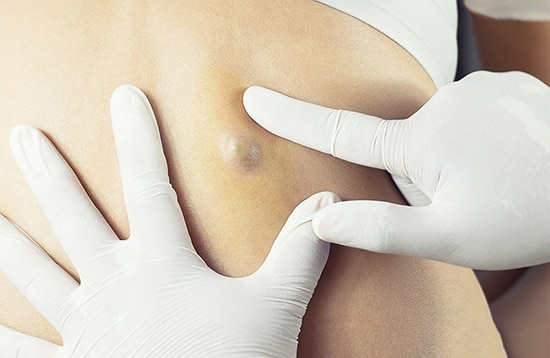Cysts
What Is a Cyst?
A cyst is a visible lump which sits underneath the skin and may be soft or firm. There are many different types of cyst. The most common is the epidermal cyst which contains a soft, yellowish material called keratin. The term sebaceous cyst is often used interchangeably.
Cysts tend to be harmless and can be left alone. If they cause you distress due to their appearance or position you may wish to have them surgically removed.

Cysts can be removed easily under local anaesthetic, but it is important for the whole of the lining to be removed to minimise the chances of the cyst growing back. At Altruderm, we send all samples to the pathology lab to confirm the doctor’s diagnosis.
Some Common Types of Cyst
Cysts are characterised by where they are located, their shape and the material inside them. The doctor will be able to diagnose the type of cyst you have by examining it.
Epidermoid Cyst
This is the most common type of cyst caused by a build up of keratin in the skin. They are slow growing lumps which tend to be skin coloured or yellowish aand are filled with a thick paste-like keratin material. They are benign but like all cysts can become infected or are simply unwanted.
Pilar Cyst
Pilar cysts run in families. You are more likely to develop them if your parents had them and they are more common in women than men. Pilar cysts form around the hair follicle and are often found on the scalp. They are round, skin coloured and firm to touch. They are also harmless but it is important to seek a medical diagnosis to ensure they are not something more sinister. A biopsy can be sent to the pathology lab for confirmation.
Ganglion Cyst
Ganglion cysts form around the joints, most typically on the wrist, hand and fingers. This type of cyst is made up of synovial fluid which is the fluid that lubricates joints to keep them moving. They are benign but as with all lumps and bumps a medical diagnosis should be sought. They can be treated by either aspiration (draining the fluid from the cyst using a syringe) or surgical removal where the cyst sac is completely removed. Again, your consultation will determine the best course of action.
Tips for Managing Cysts
Dr McDaid says:
If you think you have a cyst, but are unsure, it is important to get an accurate diagnosis. Some serious diagnoses and abnormalities of vessels can look similar to cysts. We can advise you safely at Altruderm.
Frequently Asked Questions
What causes a cyst?
Different types of cysts are caused for different reasons. For example, pilar cysts can run in families and are hereditary, whereas epidermoid cysts may appear because a hair follicle becomes inflamed. It is important to seek a medical consultation to ensure a correct diagnosis which may determine the best course of treatment, but also so that you are fully informed about the risks and benefits of the procedure including likelihood of recurrence.
How can I get rid of a cyst?
You may be tempted to try to squeeze out a cyst yourself, however this is not advisable as it can lead to inflammation, infection and also cause scarring. Cysts, depending on the type, size and location can be treated in different ways ranging from draining the cyst, injecting the cyst with steroid and surgical removal. At Altruderm, your consultation with the doctor will determine which method is most suited to your needs.
Where can I find out more information online about cysts?
The British Association of Dermatologists has a useful Patient Information Leaflet about cysts on their website which explains the different types of cysts and treatment options.
The NHS Choices website also has useful information about types of Skin Cysts.
Find out more about how we remove cysts including patient results at the Altruderm clinic.



